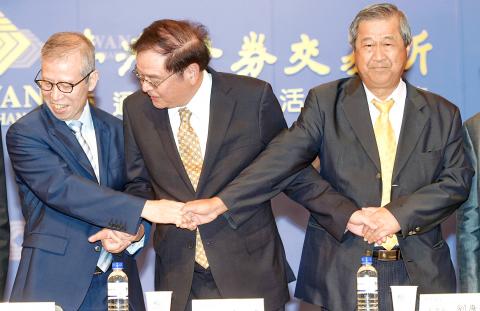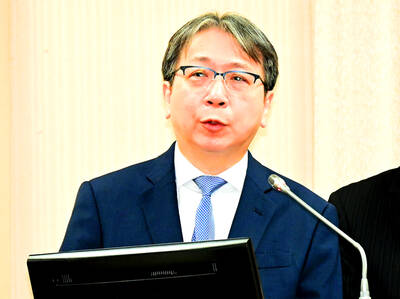Taiwanese solar cell makers Neo Solar Power Energy Corp (新日光能源), Gintech Energy Corp (昱晶能源) and Solartech Energy Corp (昇陽光電) yesterday inked a letter of intent to merge via a share swap in an bid to compete with global rivals.
The resultant entity would be the world’s second-largest solar company in terms of installed capacity, the companies said.
The firms plan to sign a trilateral merger agreement in late December and aim to complete the transaction in the third quarter of next year, they said in a joint statement.

Photo: Chang Chia-ming, Taipei Times
“The nation’s solar power industry has been struggling for years. We believe the merger will create a competitive business model,” Neo Solar chairman Sam Hong (洪傳獻) told a news conference at the Taiwan Stock Exchange.
By melding each company’s capabilities, the new firm is to offer vertical integration services from solar cell and module manufacturing, to photovoltaic systems assembly, Hong said.
The new entity would also have a more competitive cost structure, given its larger scale, he said.
The new company would have a total installed capacity of 5 gigawatts (GW) of solar cells — about 10 percent of the global market based on the projected worldwide installed capacity of 500GW this year, Hong said.
The companies also plan to expand their combined annual production capacity of solar modules to more than 3GW two to three years after the merger, compared with their current 1GW, Hong said.
The firms also aim to sell 1GW of photovoltaic systems annually within five years, he said.
Based on the letter of intent, Gintech shareholders will be able to swap each of their shares for 1.39 common shares of Neo Solar, while Solartech shares can be swapped for 1.17 Neo Solar shares, the companies said.
After Gintech and Solartech are absorbed into Neo Solar, the company is to be renamed United Renewable Energy Co (UREC, 聯合再生能源), the statement said, adding that Hong is to be the chairman and Gintech president Pan Wen-whe (潘文輝) is to serve as chief executive officer.
The deal was granted the government’s verbal support ahead of the announcement, as it is in line with the administration’s policy of developing the nation’s renewable energy industry and increasing the contribution of “green” power to the nation’s energy grid to 20 percent by 2025, Hong said.
The firms are to soon apply for capital injections from the National Development Fund and government affiliate Yao Hua Glass Co (耀華玻璃), Hong said.
It is too early to say how much UREC will receive from the government and whether it would hold a seat on the company’s board, Hong said.
The National Development Council said it has not yet received the application, but added that it supports the consolidation of solar firms to increase production capacity and competitiveness.
In a separate announcement, Neo Solar yesterday said it is to acquire 46.1 million shares, or 24.11 percent, of General Energy Solutions Inc (永旺能源) for NT$20.7 per common share in the open market from today to Nov. 6.
The company is making the move in a bid to increase its ownership in General Energy from 75.89 percent to 100 percent.
“We believe we can provide better renewable energy solutions via Neo Solar’s manufacturing strength and General Energy’s power plant building and managing capabilities,” Neo Solar said in a news release.

The US government has signed defense cooperation agreements with Japan and the Philippines to boost the deterrence capabilities of countries in the first island chain, a report by the National Security Bureau (NSB) showed. The main countries on the first island chain include the two nations and Taiwan. The bureau is to present the report at a meeting of the legislature’s Foreign Affairs and National Defense Committee tomorrow. The US military has deployed Typhon missile systems to Japan’s Yamaguchi Prefecture and Zambales province in the Philippines during their joint military exercises. It has also installed NMESIS anti-ship systems in Japan’s Okinawa

‘WIN-WIN’: The Philippines, and central and eastern European countries are important potential drone cooperation partners, Minister of Foreign Affairs Lin Chia-lung said Minister of Foreign Affairs Lin Chia-lung (林佳龍) in an interview published yesterday confirmed that there are joint ventures between Taiwan and Poland in the drone industry. Lin made the remark in an exclusive interview with the Chinese-language Liberty Times (the Taipei Times’ sister paper). The government-backed Taiwan Excellence Drone International Business Opportunities Alliance and the Polish Chamber of Unmanned Systems on Wednesday last week signed a memorandum of understanding in Poland to develop a “non-China” supply chain for drones and work together on key technologies. Asked if Taiwan prioritized Poland among central and eastern European countries in drone collaboration, Lin

TRAGEDY STRIKES TAIPEI: The suspect died after falling off a building after he threw smoke grenades into Taipei Main Station and went on a killing spree in Zhongshan A 27-year-old suspect allegedly threw smoke grenades in Taipei Main Station and then proceeded to Zhongshan MRT Station in a random killing spree that resulted in the death of the suspect and two other civilians, and seven injured, including one in critical condition, as of press time last night. The suspect, identified as a man surnamed Chang Wen (張文), allegedly began the attack at Taipei Main Station, the Taipei Fire Department said, adding that it received a report at 5:24pm that smoke grenades had been thrown in the station. One man in his 50s was rushed to hospital after a cardiac arrest

ON ALERT: Taiwan’s partners would issue warnings if China attempted to use Interpol to target Taiwanese, and the global body has mechanisms to prevent it, an official said China has stationed two to four people specializing in Taiwan affairs at its embassies in several democratic countries to monitor and harass Taiwanese, actions that the host nations would not tolerate, National Security Bureau (NSB) Director-General Tsai Ming-yen (蔡明彥) said yesterday. Tsai made the comments at a meeting of the legislature’s Foreign Affairs and National Defense Committee, which asked him and Minister of National Defense Wellington Koo (顧立雄) to report on potential conflicts in the Taiwan Strait and military preparedness. Democratic Progressive Party (DPP) Legislator Michelle Lin (林楚茵) expressed concern that Beijing has posted personnel from China’s Taiwan Affairs Office to its